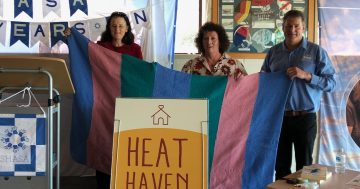
From left, Brigitte Warburton, Cathi Young, Marie Sutton and Ammanda Donnelly, with Stephen Cornthwaite (far right) of Micro Energy Systems Bodalla, who installed the school’s new solar system. Photo: SHASA.
During the Black Summer, Moruya Preschool became a small haven for families who felt safer within its walls than at their remote and often isolated homes.
Thanks to a $25,000 grant, the preschool is now well on the way to becoming better prepared for any future occurrences of smoke and fires.
The major components of the haven project include a solar system, battery storage and an external shed for storing the major components of the system are all installed – with the HEPA air filters on the way.
Moruya Preschool director Marie Sutton explained that although the preschool is a relatively small space, during the 2019/20 summer, parents and staff were able to shelter there.
“One of our staff members, Brigitte, who lives out at Congo surrounded by bush and national park, was feeling very uncomfortable about staying out there.
“So, she came up with the idea of coming out here because it is a safe space, close to town and safe for children, – and she brought her grandchildren along with her, too,” Marie said.

The solar PV array forms part of Moruya Preschool Kindergarten’s capacity as a bushfire haven. Photo: SHASA.
Another member of staff – Ammanda Donnelly – had already given up her own accommodation to others who had lost their homes and also joined Brigitte at the preschool. Then, others came along until there were about eight families, around 10 children and the preschool’s chooks.
Some people, like Ammanda, stayed for 10 to 12 days. Others waited just until the highway was open again so they could return home.
For Ammanda, it really was a refuge and allowed the community to come together.
“For the kids, it was great for them to be away from all the stress of the bushfires and just play with one another.
“The adults would take turns cleaning the gutters, cutting down some trees that needed to be removed and staying up late in the smoke ember watching,” she said.
Marie hopes that as soon as all of the new components are installed, the preschool will be open to the community during instances of not only bushfires but also heatwaves.
“When we do get the generator, I’m hoping we can be open as a place for people to come and charge their phones or even get a cold drink,” Marie said.

The Moruya Preschool Kindergarten team, from left, Brigitte Warburton, Cathi Young, Marie Sutton, Ammanda Donnelly and David Farrell. Photo: SHASA.
At the time, the preschool was not especially well-equipped to provide this service apart from having air conditioning, a water tank and normal hoses.
The Southcoast Health and Sustainability Alliance (SHASA) was instrumental in securing the funding for the preschool. It’s now the 12th community facility it’s been able to assist through the Community Facility Solar Installation Program.
“We have been doing sustainability for a long time and while SHASA had helped us to apply previously for a grant to get some solar panels, we were unsuccessful,” Marie explained.
With the grant they were able to engage the services of long-term SHASA partner – Bodalla based renewables specialist Micro Energy Systems Australia (MESA) – to install the new solar system.
Funding was received through the News Corp Bushfire Fund administered by the Foundation for Rural and Regional Renewal.
A separate grant which the preschool is in the process of applying for is likely to mean they can also add a fire/hose pump and a backup generator.
Marie explained that there are many reasons the preschool team wants to run a sustainable operation as well as simply wanting to keep their environmental footprint as small as possible.
As a not-for-profit, Marie said it’s vital to keep running and operational costs low so that all of the money can go back into the service to keep resources and staffing up.
For her, it’s also important that the children are exposed to learning about sustainability from a young age.
“We explain it as things we are doing to help the world.”







